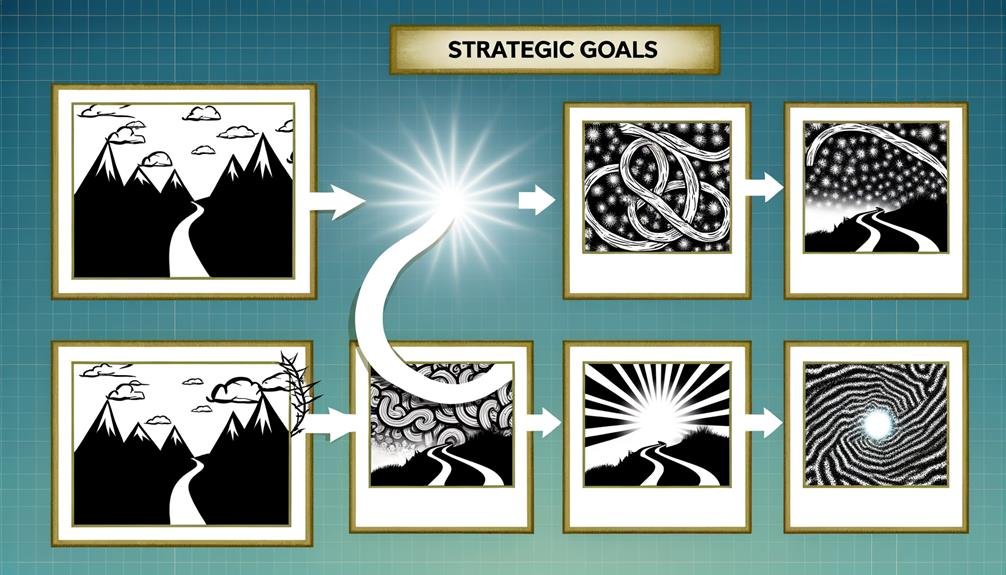Strategic Objectives: Key to Successful Implementation
Effective strategic objectives serve as the cornerstone of organizational success, providing a roadmap for achieving desired outcomes and guiding decision-making processes. However, the mere establishment of strategic objectives is not enough; their successful implementation hinges on a multitude of factors that extend beyond their mere creation.
From aligning with organizational culture to engaging stakeholders and fostering accountability, the journey towards realizing strategic objectives is a complex and multifaceted one. By exploring the nuanced interplay between strategic objectives and organizational dynamics, we uncover the critical elements that underpin successful implementation strategies, shedding light on the intricate process of transforming visions into tangible results within the ever-evolving business landscape.
Key Takeaways
- Strategy implementation hinges on understanding people, culture, and clear plans.
- Crafting measurable objectives with stakeholders ensures accountability and success.
- Defining current and future situations aligns vision and goals for success.
- Clear, concise, and meaningful strategic objectives with communication lead to successful implementation.
Importance of People and Culture
In the successful implementation of strategic objectives, the pivotal role played by people and organizational culture cannot be overstated. Cultural integration and a people-centric approach are essential for aligning strategies with the workforce and fostering a cohesive implementation process.
Understanding the values, beliefs, and behaviors within an organization is crucial for ensuring buy-in and commitment to the strategic objectives. Leaders should involve stakeholders in crafting clear plans that resonate with the existing culture and empower employees to drive change effectively.
Steps for Creating Successful Objectives
Cultural integration and a people-centric approach are foundational elements in aligning strategic objectives with the workforce and fostering a cohesive implementation process. Crafting meaningful objectives is crucial for successful strategy execution. Involving key stakeholders in the objective-setting process enhances buy-in and ensures alignment with organizational goals.
Clear, simple, and measurable objectives help in tracking progress and holding individuals accountable for their contributions. Lack of well-defined objectives can lead to confusion and a lack of direction within the workforce. Therefore, engaging stakeholders in defining and agreeing upon these objectives is paramount. By emphasizing stakeholder involvement and the creation of clear, meaningful objectives, organizations can set a strong foundation for successful implementation of their strategic plans.
Defining Current and Future Situations
Understanding the present state and envisioning the future trajectory are fundamental steps in formulating strategic pathways for organizational advancement.
Current situation analysis involves defining where the organization currently stands, aligning on key questions with stakeholders, and grasping the critical implications of not executing the strategic vision. It is crucial to agree on the current situation to advance strategies effectively.
On the other hand, future goal setting entails determining where the organization aims to be, agreeing on future goals with stakeholders, and establishing the rationale behind the strategic direction. Future goals could involve market diversification or talent engagement, ultimately setting the organization up for success.
Analyzing the current situation and setting clear future goals are pivotal in driving strategic success.
Creating Clear Strategic Objectives
Analyzing the organization's current state and setting precise future objectives are essential steps in developing a strategic roadmap for organizational advancement. When creating clear strategic objectives, it is crucial to follow SMART goal setting principles. Objectives should be Specific, Measurable, Achievable, Relevant, and Time-bound to ensure they are well-defined and achievable.
Strategic alignment is also key; objectives must align with the organization's overall strategy to drive progress effectively. Breaking down the overall strategy into concise, SMART objectives helps in ensuring clarity and focus. Communication of these objectives is vital for understanding and fostering accountability within the organization.
Clear, simple, and meaningful objectives, when communicated effectively, pave the way for successful implementation and organizational growth.
Tris Brown and LSA Global Overview
Tris Brown, the esteemed Chairman and CEO of LSA Global, brings over 25 years of extensive consulting and management experience to the forefront of organizational strategies and leadership training. With previous leadership roles at Proxicom and Outward Bound, Brown's author's expertise lies in consulting, management, and corporate leadership training for Fortune 1000 corporations.
LSA Global, under Tristam Brown's leadership, focuses on strategic direction, client services, and offers consulting services in various organizational aspects. The company provides management training and development programs tailored to Fortune 1000 corporations.
Brown's current involvement in various boards, including Outward Bound California, reflects a commitment to organizational development, aligning with his professional expertise in the field.
Active Involvement of Constituents
Active engagement of constituents is paramount for the successful implementation of strategic objectives. To ensure effective stakeholder involvement, organizations should implement various engagement strategies. These strategies may include regular communication sessions, feedback mechanisms, involvement in decision-making processes, and providing opportunities for constituents to contribute their ideas and concerns. By actively involving stakeholders in the strategic planning and implementation processes, organizations can gain valuable insights, build strong relationships, and increase commitment to the objectives set forth. The table below outlines some key engagement strategies that can be utilized to enhance stakeholder involvement:
| Engagement Strategies | Description |
|---|---|
| Regular Communication | Consistent updates and information sharing with stakeholders |
| Feedback Mechanisms | Systems in place for stakeholders to provide input and suggestions |
| Involvement in Decision-making | Opportunities for stakeholders to participate in key decision-making processes |
Crafting Measurable Objectives
To ensure the successful implementation of strategic objectives, organizations must focus on crafting measurable objectives that align with the active engagement of constituents.
Crafting measurable objectives involves setting clear performance metrics that allow for tracking progress and evaluating goal attainment. By defining specific and quantifiable targets, organizations can enhance accountability and ensure that all stakeholders understand what needs to be achieved.
Measurable objectives serve as a roadmap for success, providing a means to assess whether the strategy is on track and making adjustments as necessary. Through the establishment of measurable objectives, organizations can improve transparency, facilitate communication, and increase the likelihood of achieving desired outcomes in a timely manner.
Understanding Present for Advancing Strategies
Understanding the current organizational landscape is paramount for advancing strategic initiatives effectively and efficiently. Present analysis plays a crucial role in identifying strengths, weaknesses, opportunities, and threats that can impact the implementation of strategic objectives.
By comprehensively assessing the present situation, organizations can determine the strategic advancement needed to bridge the gap between the current state and the desired future state. This analysis enables decision-makers to align resources, capabilities, and actions with the strategic direction of the organization.
Recognizing the critical aspects of the present environment and its implications for the future is essential for developing a robust and sustainable strategy. Strategic advancement relies on a deep understanding of the present context to drive meaningful progress towards organizational goals.
Communication of Objectives for Accountability
Recognizing the critical importance of articulating and effectively communicating strategic objectives is fundamental for fostering accountability within organizational initiatives.
Stakeholder engagement plays a pivotal role in ensuring that objectives are clearly understood and embraced by all involved parties.
By involving key stakeholders in the communication process, organizations can enhance buy-in and commitment to the set objectives.
Additionally, outlining specific accountability measures within the communication strategy can help in tracking progress, identifying areas for improvement, and ultimately holding individuals and teams responsible for their contributions towards achieving the strategic objectives.
Clear and transparent communication of objectives not only aids in aligning efforts but also establishes a framework for assessing and measuring success within the organization.
Conclusion
In conclusion, the alignment of strategic objectives with organizational culture and people is essential for successful implementation.
By defining clear, measurable objectives that resonate with stakeholders and actively involving constituents in the process, organizations can navigate towards achieving their goals with precision.
Understanding the current and future landscape, along with effective communication, are key components in driving accountability and progress.
Through these strategic principles, organizations can chart a path towards success with purpose and clarity.







